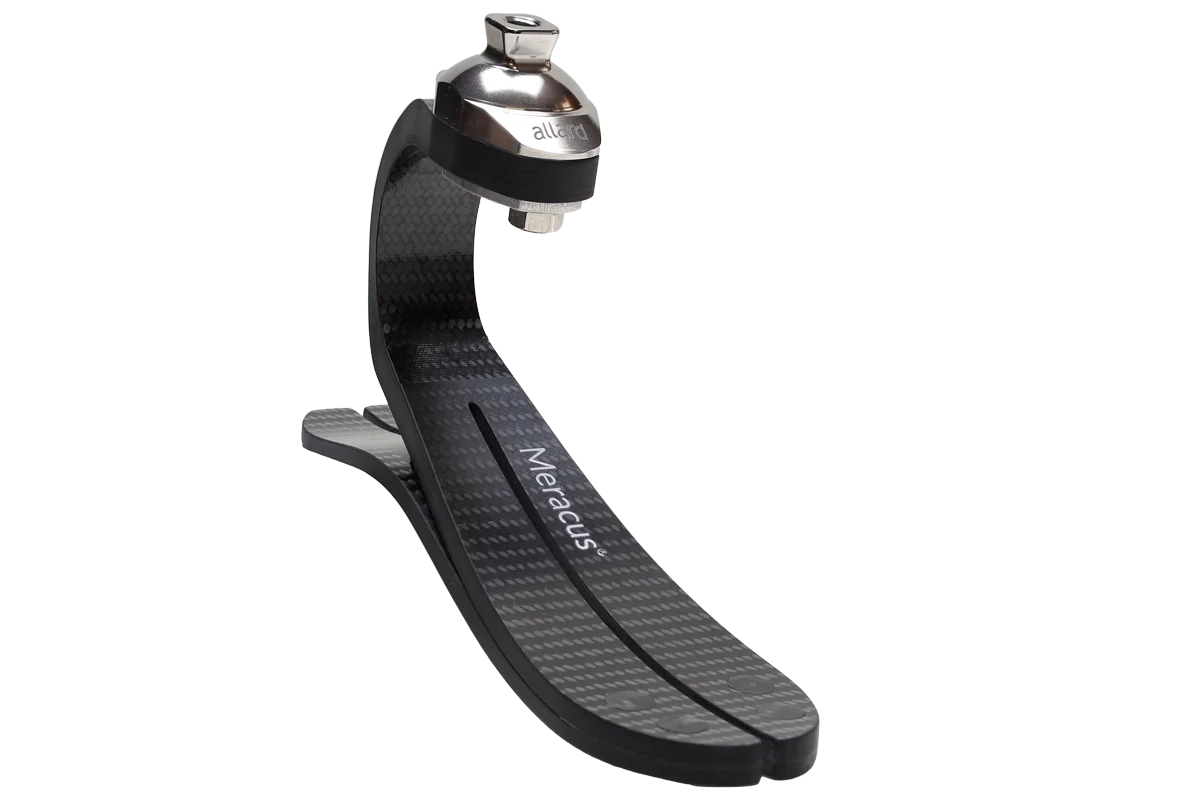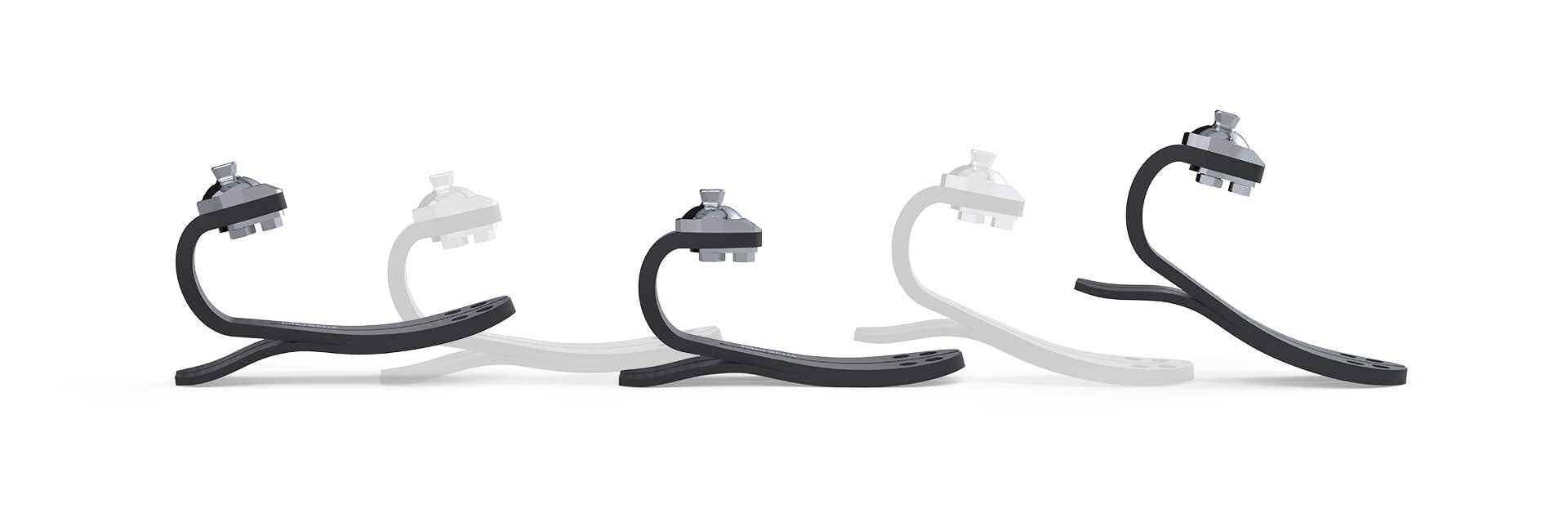Introducing Meracus®:
the 100% composite prosthetic foot
Meracus® is developed using proven concepts, designed to provide a natural and confident stride at every stage of the gait cycle. Through meticulous design, research and testing, the Allard team has crafted a prosthetic foot with dynamic properties which mimics the anatomical foot.

Meracus® dynamic design provides:
- shock absorption at heel strike
- a smooth transition into a stable stance phase
- a smooth rollover and an efficient energy return during push-off
- support and comfort while standing
- flexibility and versatility for everyday activities
Frequently Asked Questions: Meracus® and Foot Prosthetics
A prosthetic foot is used to replace the foot after an amputation and is essential to provide the user with stability and comfort when walking.
The prosthetic socket is the interface between the residual limb and the prosthesis. It is customised to provide the best possible fit and comfort. It usually consists of an inner liner, made of soft material such as silicone or gel, which protects the skin and reduces friction, and an outer sleeve that provides support and stability.
The foot module is the part that replaces the foot itself. It is designed to provide natural movement and can be customised for different activity levels. There are different types of foot modules, including dynamic feet that provide energy recovery and simple, fixed feet for basic stability. The prosthetic foot's adapter is connected to the pylon, which in turn is connected to the adapter of the socket and used to optimize alignment, improving stability and gait.
Meracus® prosthetic foot consists of a pyramid adapter, J-shaped composite keel and a full-length composite heel plate. Meracus® is made of 100% composites with a unique composition of carbon, fiberglass and resin. Allard's patent pending composite rivets assist with removing “Dead spots” in the user’s gait. The rivets are created by Allard's proprietary composite formula and ensure that the Meracus® recipe is 100% composite material.
There are different types of prosthetic feet with different functionality to fit indivual needs. Some types of prosthetic feet include:
- Dynamic Response foot
- Solid Ankle Cushioned Heel (SACH) foot
- Axial foot
- Hydraulic Ankle foot
- Microprocessor foot
- Partial Foot Prosthetic
- Specialty Prosthetic foot
- Elastic Keel foot
Meracus® is a Dynamic Response foot. Key features include: Kinetic energy return, Shock absorption, Flexibility, Adjustability and Adaptability.
Talk to a certified clinician (CPO/CO) to see if Meracus® could be a good option for you. We offer a 30-day trial policy so that you can make sure it is the right foot for you. Contact one of our District Managers if you need assistance in finding a clinician near you.
With the right conditions, you can walk normally with a foot prosthesis like the Meracus® prosthetic foot. Meracus® is designed to replace the function of an amputated foot and ankle, offering dynamic properties that simulate an anatomical foot by providing shock absorption, stability, and energy return. A patient's general health, muscle strength and balance play a significant role in their ability to walk with foot prosthetics. To walk comfortably and make the most of their new prosthetic foot, patients need proper training, information, and time to adjust to the prosthesis.
The Meracus® prosthetic foot is designed to support moderate to active physical activities, including walking, hiking and occasional running. For those considering high-impact sports, a specialized prosthetic foot may be required to ensure safety and performance.
Meracus® prosthetic foot is a suitable option for different lower-limb amputation levels, but not all.
- Above Knee (Transfemoral): Meracus® is a suitable option for K3 TF amputees.
- Knee Disarticulation (Thru Knee): Meracus® is a suitable option for K3 Knee Disartic amputees.
- Below Knee (Transtibial): Meracus® is usually a suitable option for K3 TT amputees. An exception would be a distal transtibial amputation where the Meracus® low build height might not be low enough. For these cases a LP (Low Profile) foot may be better suited.
- Hip Disarticulation (Thru hip): Meracus® may be too flexible as amputation levels this high up the chain can be in need of more supportive (stiffer) components.
- Partial Foot: Meracus® is not an option.
How long a prosthetic foot lasts depends on how actively the foot is used and how well it is maintained. Meracus® prosthetic foot has undergone a dynamic test in two million cycles, in accordance with standard ISO 22675 (at a P7 load level for 150kg (330lbs.). We offer a warranty of 36 months (3yrs) for the prosthetic foot and 6 months for the foot shell.
Meracus® prosthetic foot weighs approximately 580-750 gram (1.3-1.6lbs) including the foot shell. The weight varies based on the size and P-level (weight level). Read more about sizing on the Meracus® Product Page.
You can wear regular shoes with a prosthetic foot. Meracus® works well with most shoes. A foot shell is used with the prosthetic foot to help fill out the shoe and ensure a better fit. However, if you plan to wear different types of shoes with your prosthetic foot, it’s important to consult with your Prosthetist as this might affect the alignment of the prosthetic.
Using a foot shell with your prosthetic foot is essential. The foot shell provides protection for the composite prosthetic foot, preventing wear and tear. Additionally, it fills out the shoe, ensuring a better fit and appearance. Without a foot shell, the prosthetic foot can become slippery, especially in situations such as when showering/bathing or on smooth surfaces. Therefore, to ensure safety and longevity, it is highly recommended to always use a foot shell with your prosthetic foot.
Maintaining your prosthesis regularly is essential to ensure its long-term function and comfort.
- Use a soft cloth and mild detergent for daily cleaning of your prosthetic foot and to remove dirt.
- Avoid using harsh chemicals that can damage the material.
- Regularly check the prosthesis for signs of wear, such as cracks or loose parts, and report these to your orthotist immediately.
To maintain an optimal fit, you should also follow up with your orthotist for regular adjustments. Your residual limb may change over time, which can affect how your prosthesis fits. Regular visits will ensure that the prosthesis is adjusted to your current needs, preventing discomfort and chafing.
Always follow the manufacturer's instructions and advice from your care team for specific maintenance procedures.
Testimonials about Meracus®
”So soft and flexible, feels like my own foot!”
”The foot "rolls" better through the step. It feels flexible and easy to walk with. ”
"It feels like a real foot – I don't need to limp with this."
”It's stable but also flexible, both through the step and sideways.”


